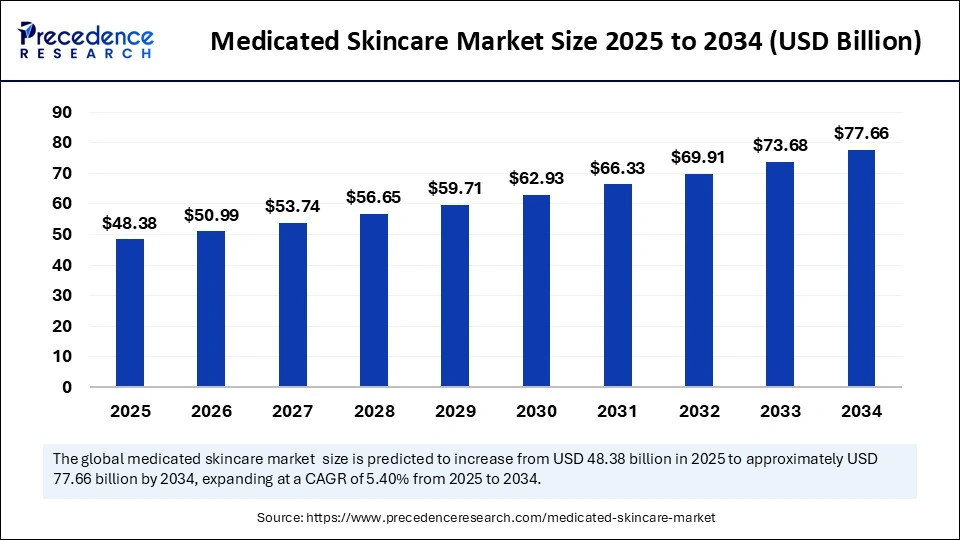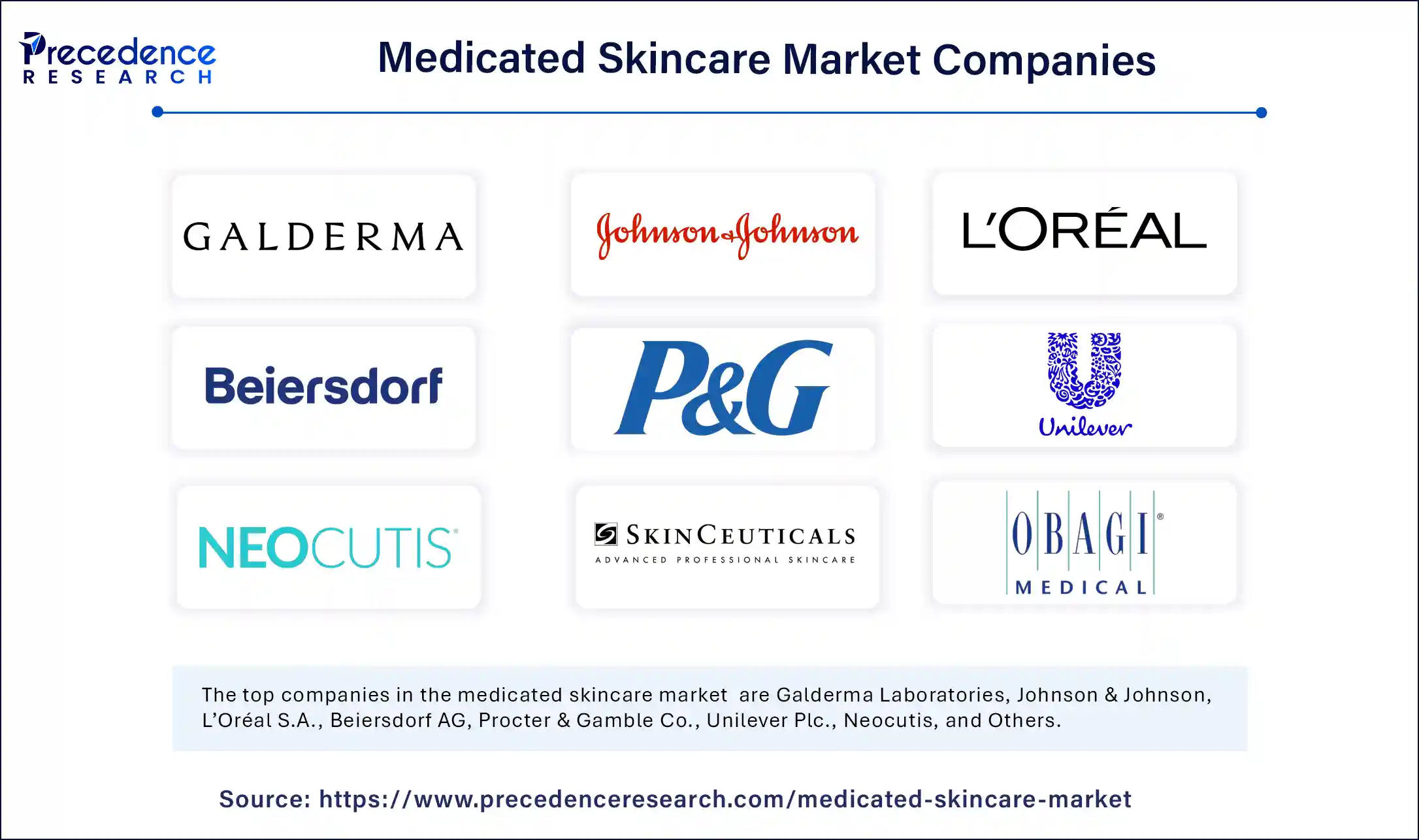
Medicated Skincare Market Key Points
- In 2024, North America led the medicated skincare market with the highest regional share, while Asia Pacific is forecasted to register the fastest CAGR during the projection period.
- By skin condition, acne treatments accounted for a notable 32% market share in 2024. The psoriasis segment is expected to experience substantial growth over the coming years.
- In terms of ingredients, anti-inflammatories held the largest share at 28% in 2024, while natural and organic ingredients are projected to grow at a strong pace between 2025 and 2034.
- By application, creams remained the most widely used product format in 2024, whereas lotions are anticipated to gain significant traction during the forecast period.
- Across distribution channels, dermatology clinics led the market in 2024, with retail pharmacies emerging as the fastest-growing segment moving forward.
Market Overview
The Medicated Skincare Market has evolved into a dynamic and fast-growing segment of the global dermatology and personal care industry. It refers to products formulated with active pharmaceutical ingredients (APIs) designed to treat specific skin disorders and concerns such as acne, eczema, psoriasis, fungal infections, rosacea, hyperpigmentation, and other dermatological conditions. These products range from over-the-counter (OTC) topical treatments to prescription-based skincare regimens and include formats like creams, ointments, gels, serums, face washes, and medicated soaps. The convergence of cosmetic and therapeutic benefits—often referred to as cosmeceuticals—has further blurred the lines between traditional skincare and pharmaceutical treatment, making medicated skincare both a clinical and consumer-driven market.
Rising consumer awareness of skin health, increased incidences of dermatological issues due to pollution, stress, and hormonal imbalances, and growing demand for dermatologist-recommended solutions have contributed to the market’s sustained expansion. Additionally, the social media influence on beauty standards, coupled with the stigmatization of visible skin conditions, is compelling consumers to seek fast-acting, efficacious skincare solutions, thereby fueling demand for medicated products. The global market also benefits from growing skincare routines in both male and female demographics, across all age groups.
Medicated Skincare Market Growth Factors
Multiple factors are accelerating the growth of the medicated skincare market. A key growth driver is the rising prevalence of skin disorders worldwide, especially in urban areas where pollution, changing lifestyles, and increased exposure to allergens have led to a surge in acne, dermatitis, and fungal infections. The increasing number of people with sensitive skin, allergies, and chronic dermatological conditions is expanding the consumer base for medicated skincare products.
Another important growth catalyst is the aging population, particularly in developed markets. Older demographics are more susceptible to conditions like dry skin, rosacea, and age spots, which often require targeted medicated solutions. This is compounded by the broader trend of proactive skin maintenance among aging consumers who seek both cosmetic and therapeutic benefits.
Moreover, greater access to dermatological care and information, facilitated by online platforms, teledermatology, and digital health tools, has empowered consumers to seek timely treatment and use clinically endorsed products. This democratization of skincare knowledge is a major driver behind the surge in demand for prescription-grade and OTC medicated skincare solutions.
The market is also benefitting from advancements in formulation science, including the use of biologics, peptides, retinoids, and anti-inflammatory agents that offer more targeted and less invasive treatment options. These innovations not only improve efficacy but also reduce side effects, making medicated skincare more appealing to a wider consumer base.
Impact of AI on the Medicated Skincare Market
Artificial Intelligence (AI) is increasingly transforming the medicated skincare landscape across product development, diagnosis, personalization, and consumer engagement. In R&D, AI is accelerating the discovery of new active ingredients and formulations by analyzing vast datasets related to skin conditions, genetic markers, and environmental triggers. Machine learning algorithms can simulate skin reactions to specific compounds, thus speeding up product innovation while reducing development costs and trial times.
AI is also revolutionizing diagnosis and treatment recommendation through tools like skin analysis apps and AI-powered dermatology platforms. These tools can scan images of the skin, detect conditions like acne or rosacea, and suggest medicated skincare products tailored to an individual’s specific skin type and condition. This level of hyper-personalization is reshaping consumer expectations and allowing brands to deliver more effective treatment solutions.
In marketing and customer service, AI chatbots and virtual skincare consultants are being used to provide real-time product guidance, track treatment progress, and deliver reminders for product usage—enhancing adherence and satisfaction. Moreover, AI-driven trend analysis helps brands understand emerging skin health concerns and forecast demand, aiding in agile product strategy.
AI is also helping improve supply chain efficiency and product traceability, ensuring better distribution of dermatological products and reducing counterfeit risks—an important factor in the healthcare-oriented skincare market.
Market Scope
| Report Coverage | Details |
| Market Size by 2034 | USD 77.66 Billion |
| Market Size in 2025 | USD 48.38 Billion |
| Market Size in 2024 | USD 45.90 Billion |
| Market Growth Rate from 2025 to 2034 | CAGR of 5.40% |
| Dominating Region | North America |
| Fastest Growing Region | Asia Pacific |
| Base Year | 2024 |
| Forecast Period | 2025 to 2034 |
| Segments Covered | Skin Condition, Ingredient, Application, Distribution Channel and Regions |
| Regions Covered | North America, Europe, Asia-Pacific, Latin America, and Middle East & Africa |
Market Drivers
-
Increasing prevalence of chronic skin conditions such as acne, psoriasis, and eczema worldwide.
-
Growing demand for dermatologist-formulated and clinically tested skincare products, particularly among educated, urban populations.
-
Proliferation of e-commerce and direct-to-consumer skincare brands, offering easier access to specialized products.
-
Rising disposable income and consumer willingness to invest in high-efficacy skincare solutions.
-
Integration of pharmaceuticals into cosmetics, leading to innovation in multifunctional products that offer both aesthetic and therapeutic benefits.
Opportunities
-
Expansion in emerging markets, particularly in Asia-Pacific, Latin America, and Africa, where rising incomes and improving healthcare access are creating new consumer segments.
-
Development of vegan, cruelty-free, and clean-label medicated skincare products, responding to a shift in consumer values toward ethical and sustainable consumption.
-
Personalized skincare regimens using AI and biotechnology, including DNA-based product customization.
-
Increased focus on pediatric and men’s medicated skincare, which remains underdeveloped relative to women’s segments.
-
Partnerships between dermatologists and beauty tech startups, which can help bridge the gap between medical credibility and consumer lifestyle appeal.
Challenges
-
Regulatory hurdles and product classification ambiguities, as products straddle the line between cosmetics and pharmaceuticals, requiring careful compliance with FDA, EMA, and other regulatory standards.
-
High cost of formulation and clinical validation, which can be a barrier for new entrants and smaller brands.
-
Side effects and allergic reactions, which can lead to product recalls or loss of consumer trust, particularly if labeling is unclear or usage guidance is insufficient.
-
Market saturation and counterfeit products, especially in online sales channels, can hinder consumer confidence and brand differentiation.
-
Consumer misinformation or self-diagnosis, which may result in inappropriate product use and reduce treatment efficacy.
Regional Outlook
North America remains a dominant market for medicated skincare, driven by high consumer awareness, strong dermatology infrastructure, and the presence of key market players. The U.S., in particular, is a major hub for innovation in acne treatment, anti-aging, and prescription skincare solutions, supported by robust health insurance coverage for dermatological conditions.
Europe holds a significant share due to its large aging population, a strong preference for high-quality skincare, and strict but supportive regulatory frameworks that promote product safety and efficacy. Countries such as Germany, France, and the UK are key markets for medicated cosmeceuticals and pharmacy-distributed skincare brands.
Asia-Pacific is poised to witness the fastest growth in the coming years, owing to a rapidly growing middle class, increased urbanization, and heightened awareness of skin health and appearance. South Korea, Japan, China, and India are emerging as innovation hubs, with increasing interest in herbal-medicated skincare and fusion products that blend traditional medicine with modern dermatology.
Latin America and the Middle East & Africa present untapped potential. In these regions, improving healthcare access, rising internet penetration, and growing interest in personal grooming are driving gradual adoption. However, affordability and education about medicated skincare remain key barriers to wider growth.
Medicated Skincare Market Companies

- Galderma Laboratories
- Johnson & Johnson
- L’Oréal S.A.
- Beiersdorf AG
- Procter & Gamble Co.
- Unilever Plc.
- Neocutis
- SkinCeuticals
- Obagi Medical
- Dermalogica
- La Roche-Posay
- Murad
- PCA Skin
Segments Covered in the Report
By Skin Condition
- Acne
- Psoriasis
- Eczema
- Rosacea
- Others
By Ingredient
- Anti-inflammatories
- Antibacterials
- Antifungals
- Antioxidants
- Moisturizers
- Synthetic ingredients
- Natural/organic ingredients
- Chemical-based ingredients
By Application
- Creams
- Lotions
- Ointments
- Gels
- Serums
By Distribution Channel
- Dermatology Clinics
- Online Pharmacies
- Retail Pharmacies
- Others
By Region
- North America
- Asia Pacific
- Europe
- Latin America
- Middle East & Africa
Read Also: Endoscopy and Ambulatory Surgical Center Market
Get this report to explore global market size, share, CAGR, and trends, featuring detailed segmental analysis and an insightful competitive landscape overview @ https://www.precedenceresearch.com/sample/6082
You can place an order or ask any questions, please feel free to contact at sales@precedenceresearch.com|+1 804 441 9344
- Arteriovenous Implants Market Enhance dialysis outcomes with advanced grafts, endovascular access, and AI-assisted precision - September 16, 2025
- Smart Retinal Implants Market Restore vision with wireless bioelectronic prosthetics and AI-powered retinal technologies - September 16, 2025
- Myopia Treatment Devices Market Size to Reach USD 38.51 Billion by 2034, Growing at a CAGR of 7.86% - September 1, 2025
